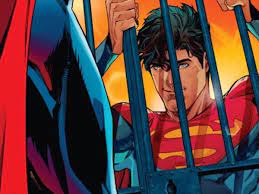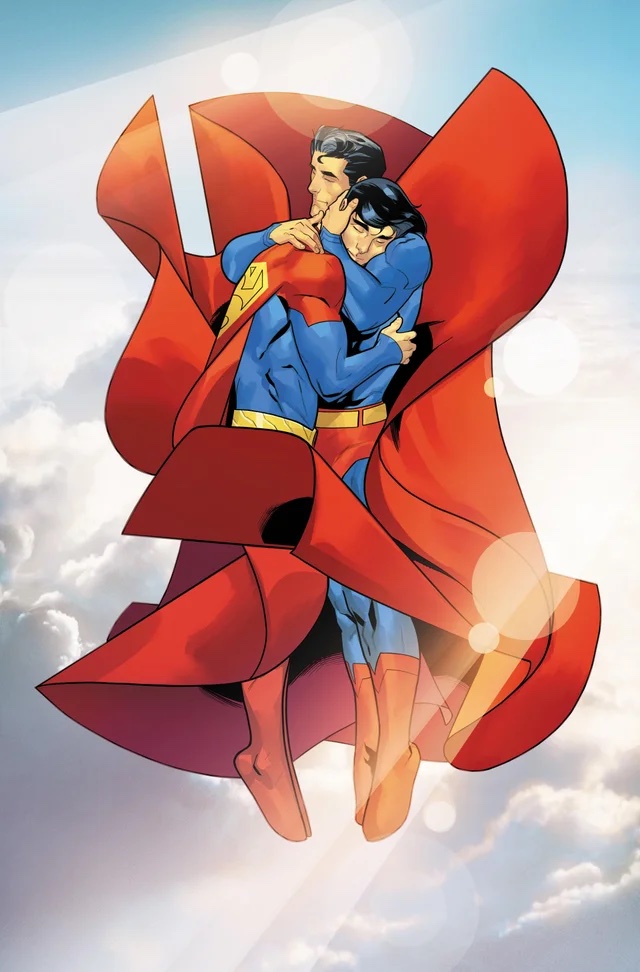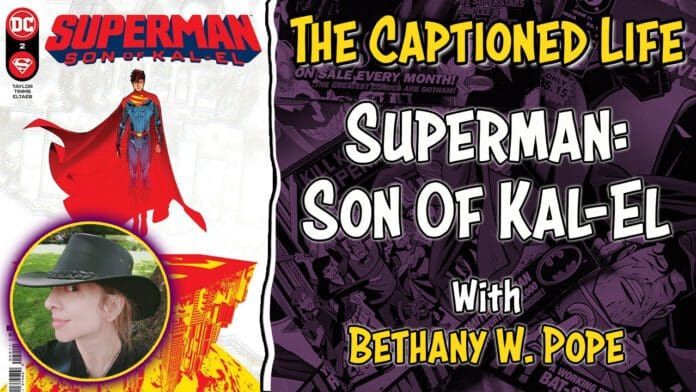Share this
NOTE: “The Captioned Life” is part of the Comic Watch Network.
This article was originally written and published for The Captioned Life Show on January 24th, 2023.
The recent run of DC Comic’s Superman: Son of Kal-El is a fantastic story about the son of Kal-El/Clark Kent and Lois Lane, Jon Kent, taking on the helm of Superman while his father is away saving another planet. During this time, Jon learns what it means to be both a superhero and human as he tackles villainous plots by President Bendix of the island nation Gamorra, determining when situations need physical violence or practical solutions, balancing a life of heroism with his love life, and relying on support from the ones he loves to make the best decision for himself, and for Earth.
I recently read the entire run from start to finish (including a couple of special tie-in issues) and I have to say that this is probably one of my favorite runs of all time for a number of reasons. There are a few major themes in this run that are worth discussing as to why this was a fantastic story from my perspective, as well as a few criticisms I have about the story. So below is a breakdown review of the series. Also, I did a deep dive analysis of Superman: Son of Kal-El with fellow Comic Watcher and author, Bethany W. Pope, for the podcast. Check out the episode and where you can watch/listen to it on your podcast player of choice here.
Overview, Synopsis, and Details
Superman: Son of Kal-El is an 18-issue series from DC Comics that ran from 2021-2022. The creative team consists of:
- Writer Tom Taylor
- Artists John Timms, Daniele Di Nicuolo, Cian Tormey, Raul Fernandez, Bruno Redondo, Wade Von Grawbadger, Matt Herms, Scott Hanna, Ruairi Coleman, Clayton Henry, Scott Hanna
- Colorists Gabe Eltaeb, Hi-Fi, Adriano Lucas, Federico Blee, Marcelo Maiolo, Romulo Fajardo Jr.
- Letterers Dave Sharpe, Wes Abbott
Here is the official synopsis of the series as written by DC Comics:
A new Man of Steel for a new era! Jonathan Kent dons his father’s cape as the 21st century Superman, from the bestselling writer of DCeased and Injustice!
Jonathan Kent has experienced a lot in his young life. He’s fought evil with Robin, traveled across galaxies with his Kryptonian grandfather, and lived in the future with the Legion of Super-Heroes, who were intent on training him for the day his father could no longer be Superman.
There is a hole in the Legion’s history that prevents Jon from knowing exactly when that will happen, but all signs point to it being very soon. It’s time for the son to wear his father’s cape and continue the never-ending battle as a symbol of hope for his home planet.
But can Jon be Superman and still have a normal life? The son of Clark Kent and Lois Lane will learn the hard way as he heads to college and combats the dangers of the modern world.
In this story, there are many themes that one can pick from. For this review, I’ll only focus on a few that really stood out to me personally.
The Humanity Of Jon Kent

Whenever we think of Superman, we automatically go to the things he does that are superior to normal human abilities: Super strength, flight, x-ray vision, heat vision, etc. Although the comics have explored the humanity of Kal-El in the past, what I love about this series is that not only does it highlight Jon’s humanity more than what we’ve seen in the past, but he’s also inspirational in showing how every day people can make as much as a difference in the world as he can by showing how that can be done without using his superpowers. For example, he shows how he is against Metropolis police arresting refugees by insisting that if they are going to arrest them, they will need to arrest him, too, as a sign of solidarity with them (and even promises not to break out of the cuffs or jail, even though he easily could).
This is a powerful way to show how instead of using his superpowers to demonstrate what he believes should be done, he takes the more peaceful, human approach of joining the oppressed to bring attention to the situation. To add on to this and to give credit where credit is due, the owner of my local comic shop (LCS), Circle City Comics, shared with me how he listened to an interview with Tom Taylor and pointed out that in the whole run, Jon only threw one punch. In all of the other conflicts he faced, he either used his super strength for protection or tried to find more practical, human ways to resolve conflicts. The fact that Jon is always thinking about how to set an example in using violence as an absolute last resort is such an amazing way to remind us how we can make a change in our own world – how we can be our own Superhuman.
Another aspect of Jon’s humanity is how much we see him relying on others for advice and affirmation on if he’s doing the right thing. His friendship with Damian Wayne is heartwarming and fun; his relationship with Jay pushes him to be the best version of himself; and his interactions with the Revolutionaries are tense but provides growth for both groups. But my favorite relationship he has is with Dick “Nightwing” Grayson.
We find out through Nightwing #89 and issue #9 of this series what happened to Jon Kent early on. He went missing (this detail is unclear to me why he went missing since I didn’t read the stories prior to this run) but Batman and Nightwing were the ones that found him in a cave, scared. Since then, Jon sees Nightwing as an older brother type, someone to look up to as his own personal hero. Their connection is magnetic for the reader, and through those two issues, you see how Dick takes Jon under his wing and tries to guide him on his journey while his father is away. I love this dynamic and more importantly how someone who is considered the most powerful being on Earth is looking up to a nonpowered human for guidance, comfort, and on one occasion, safety. It shows simultaneously the vulnerability of one, and the inspiration of another.
 LGBTQ Representation
LGBTQ Representation
One of the more prominent themes (if not the most) in this run is LGBTQ representation with Jon Kent coming out as bisexual. In fact, this series was nominated by GLAAD for Outstanding Comic Series Of The Year. It’s also been a source of controversy for those who have come to see the major comics publishing industry as being “woke”, albeit some who did not read the comics thought that this reveal was referring to Clark Kent, not realizing this was a story about his son.
Because I am not a member of this community, I do not plan to comment much about what this comic series means to the community or do an analysis of this theme. If you are curious to hear an LGBTQ person’s perspective on it, watch/listen to the podcast episode about this series where my guest, Bethany W. Pope, speaks about this theme in Superman: Son Of Kal-El.
As someone who is not a member of the community, however, I do want to say that I appreciate seeing some of these critical moments of an LGBTQ person’s life not only as a moment or panel in the story but as highlighted with a dedicated splash page. We know that representation matters, and seeing these moments as a critical part of the story and character goes beyond the pages and should be a part of normalizing this in our own world today.


Jon’s Relationship With His Father
My personal favorite theme in the story, however, is Jon’s relationship with his father. Being a father myself, I found myself identifying with Kal-El in new ways that I haven’t before since I was a kid. In a world where we are still battling toxic masculinity and what some perceive as “what it means to be a man” means never showing vulnerability or “weak” emotions, Taylor shows how the world’s most masculine man demonstrates what it truly means to be a man and parent. Kal-El doesn’t shy away from his feelings of vulnerability. He was upset with himself when he didn’t understand why Jon hasn’t told him about his sexuality. When he returns to Earth he gives his son a loving embrace to show much he loves him.
When he finally finds his son again after being lost and possibly kidnapped, he used his superspeed to quickly hug him and try to show in his actions how much he loves him and that he’s sorry for harm coming to him. In all of these moments, we always see Jon as looking up to his father, as the person who will always love him and support him, and this is the aspirational relationship we should be seeing between fathers and sons. I know that no matter how old my son gets, I will always hug him the same way Superman hugs his own son. Personally, I plan to get the artwork of Superman rushing to hug his little boy signed by the creators (Taylor, Redondo, and Lucas) one day to hang it up on the wall of my house to remind me that this is what a man looks like: loving, protective, vulnerable, all rolled into one. This story has made me teared up multiple times because I never help but think of my own son when I see these images and read this story, and think about how I would react the same way as Kal-El.


I also love how aspirational the relationship is when it comes to Jon’s sexuality. Here in this story, we see how Lois has always known and she was supportive from the start. Kal-El waited for Jon to tell him, not forcing him to come out, and even apologizes to Jon because he felt that he didn’t make it safe enough for Jon to tell him. Unfortunately, this is not a common experience for most LGBTQ people when it comes to their parents. As a father, if my child were to ever come out to me, I hope that he feels safe enough with me to do so as I want him to know that this is the same kind of love and support he would get from me.
Criticisms Of The Story
As a comics reviewer, I do believe in no matter how much you love the story, you should be able to objectively find something to critique as much as possible. It may not always happen, but I believe it can be done, and this run is no exception. I’ll be focusing more on the criticisms I have about the story than the art or colors since this ran for 18 issues and there were so many artists and colorists on the run that I don’t think it would be fair to critique it as a whole.
First, I am still a little underwhelmed with the motivation of President Bendix. I understand that he was creating a super-powered team of humans as a way to get rid of Superman and others like him, but I was still left confused as to why that was. It seemed like he was so hell-bent on doing this that I never really felt like there was a good rationale for the backstory of why he became the way he did. It is also possible that they mentioned this and I completely forgot about it so if this is the case, reach out to me and let me know and I’ll be more than happy to fix this. But at this time, I’m still wanting to know more about why Bendix was trying to accomplish this.
The mother of Jon’s boyfriend, Jay Nakamura, used to be the president of Gamorra until Henry Bendix took over. Jay didn’t know what happened to her but we find out that she was detained and eventually experimented on, turning into a monstrous creature (still human though) with powers. However, she is only mentioned and appears only a few times in the run, both of which were just odd. From my point of view, her character didn’t propel the story forward. In fact, if you took her out, the story wouldn’t really have changed much at all. I think Taylor was trying to show another instance of affirmation for Jay and Jon’s relationship, but if that was the case, it fell flat for me. I would have liked to see more of her and her relationship with Jay more in this story.
At one point in the story, Batman took Jon and Lois away to a safe house but explicitly leaves Jay behind. We find out from Batman that Jay is considered dangerous because of his association with the Revolutionaries. Batman is an already distrustful person, but this was hard on Jon. But after this whole moment, we don’t see any resolution from Batman’s distrust of Jay. Sure, we see that Jay’s background was not as black and white as Batman made it to be, but to date, it seems like that hasn’t been resolved for Batman or the wedge he drove between himself and Jon.
Final Thoughts
I honestly believe that this is a great series for anyone to check out. This has such a great and powerful story with so many themes for someone to connect with and is so well-written. It takes a step back from the “super” part of Superman and instead focuses more on the “man” part of Superman. I appreciate all that this story represents for so many people, and as a father, this will always have a special place in my heart.



 LGBTQ Representation
LGBTQ Representation